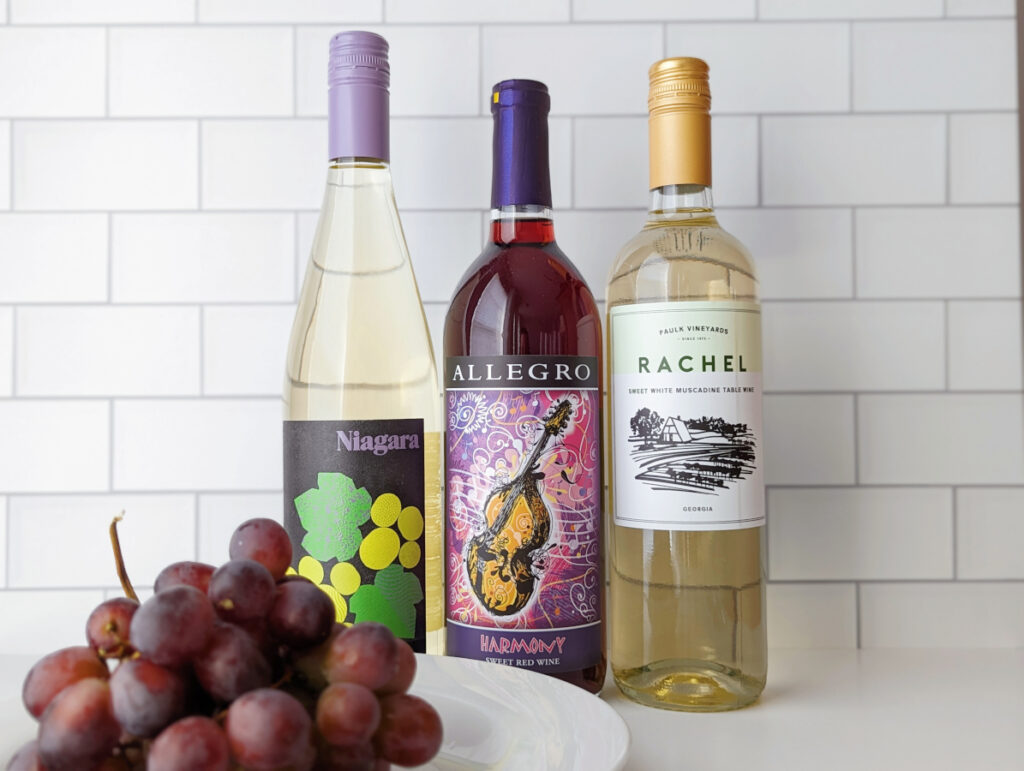
Photo by: Denise M. Gardner
Are there wine varieties that you tend to hide from admitting to other wine lovers that you enjoy?
If so, you aren’t alone.
In the world of wine, there are a series of wine grape varieties that do not receive esteemed recognition despite their regional popularity. This lack of acknowledgement has absolutely nothing to do with their quality. Instead, it has everything to do with the sensory characteristics that are naturally a part of their makeup.
What am I talking about here?

Photo by: Denise M. Gardner
I’m talking about many of the “native”* wine grapes that grow naturally in various parts the U.S. that have been cultivated for use in wine and other grape products like juice, jams, jellies, and flavors. Most wine literature stays completely away from discussing any of these varieties, deeming them basically unmentionable by the wine community. But this Sip & Swirl edition is going to explore three of the more popular varieties: Concord, Niagara, and Muscadine.
If you’re a “serious wine lover,” before you turn away from this month’s edition, I’d encourage you to read through the post because some of the history and food and wine pairings may surprise you. Plus, being inclusive to your friends and family that enjoy these wines can help encourage better wine engagement, making everyone feel worthy of their wine choices with regards to their taste preferences.
(* “Native” is put into quotes as there is debate within the literature as to which varieties are pure U.S. varieties versus the possibility that these and other varieties are more likely crosses between native and European varieties that bred accidentally while planted near each other. Also, as a side note, there are several Muscadine varieties that are noted to make “Muscadine” wine. Therefore, it’s possible the descriptors associated with the Muscadine wines tried by this author may not reflect some other Muscadine wines available on the market.)
An Incomplete History of Native U.S. Wine Varieties
During the colonization of America, it was common for settlers to bring cuttings of native grapevines from their European countries of origin. Wine was, in fact, one of the prized commodities associated with settling American land (Pinney, 1989). Many history texts often recognize that Jamestown started a vineyard for wine production, but this is true of many settlements throughout the U.S. European settlers brought with them Vitis vinifera cuttings with hopes to cultivate the vines for wine production. V. vinifera is the European grapevine species that is used for most of the wines you and I know today: Cabernet Sauvignon, Chardonnay, Pinot Grigio, etc. But, as was true with most Eastern U.S. settlements, many of these vines failed due to disease pressure associated with America, or inappropriate growing conditions that it made it difficult for V. vinifera species to survive.
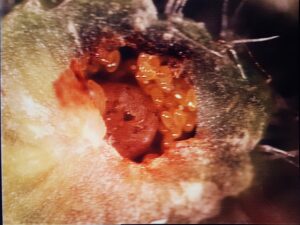
Photo by: Denise M. Gardner
One of the primary diseases that decimated European wine grape varieties, V. vinifera wine grapes, is associated with the insect phylloxera. Phylloxera is an insect, native to the U.S., that feeds on both the roots and the leaves of grapevines. European grape varieties, specifically, are quite susceptible to phylloxera. This means that the insect can damage and kill the grapevine, making it impossible for the vine to mature and produce grapes.
However, if you walk through many of the wooded regions or riverbanks of the Eastern U.S., you’ll find many native grapevines littered with phylloxera on the leaves of the vine… and the vine is still growing. In fact, most of the Eastern U.S. is rich with native grapevines in general. This is because U.S. grape varieties such as Vitis labrusca, Vitis riparia, Vitis rupestris, and Vitis rotundifolia are resistant to phylloxera and have adapted to the conditions associated with the climatic hardships of the Eastern U.S. Thus, these alternative grape species thrive in regions where V. vinifera species were incredibly difficult to grow.
Over time, the Eastern U.S. habitants experimented with the cultivation and breeding of native U.S. grapevines. While the fruit, and subsequent wines, did not taste like their European counterparts, it did not hinder the continued exploration of these varieties getting made into wine.
Today, many of these varieties still exist in production: Vitis labrusca (or Vitis labrusca hybrids depending on which text you read) includes the Niagara and Concord grapes. Vitis rotundifolia which includes the Muscadine grape species, are bred species from the Scuppernong variety. While Niagara and Concord have been popularized for grape juice (white – Niagara, red – Concord), many Northeastern, Mid-Atlantic, and Midwestern wineries also use these varieties to make wine. In the Southern states, Muscadine grape species dominate.
Thus, if you are from regions outside of where these varieties are grown, you may not be as familiar with these wines.
Furthermore, the largest wine grape growing regions are on the western part of the U.S. (California, Oregon, and Washington), where these grape varieties are not native. Additionally, these regions do see a larger volume of thriving European varieties due to the less humid and less wet growing conditions. Therefore, many of the native variety wines are not commonly a part of the national wine distribution system.
To this day, the cultivation of many native and hybrid (crosses between native and European grape species) wine grapes have remained somewhat isolated to the Eastern, Southern, and Mid-Western U.S., where it is more challenging to grow V. vinifera wine grapes for various reasons. Thus, as was prominent throughout American history, these wines remain preferred in somewhat regionally based on where those grapes are grown.
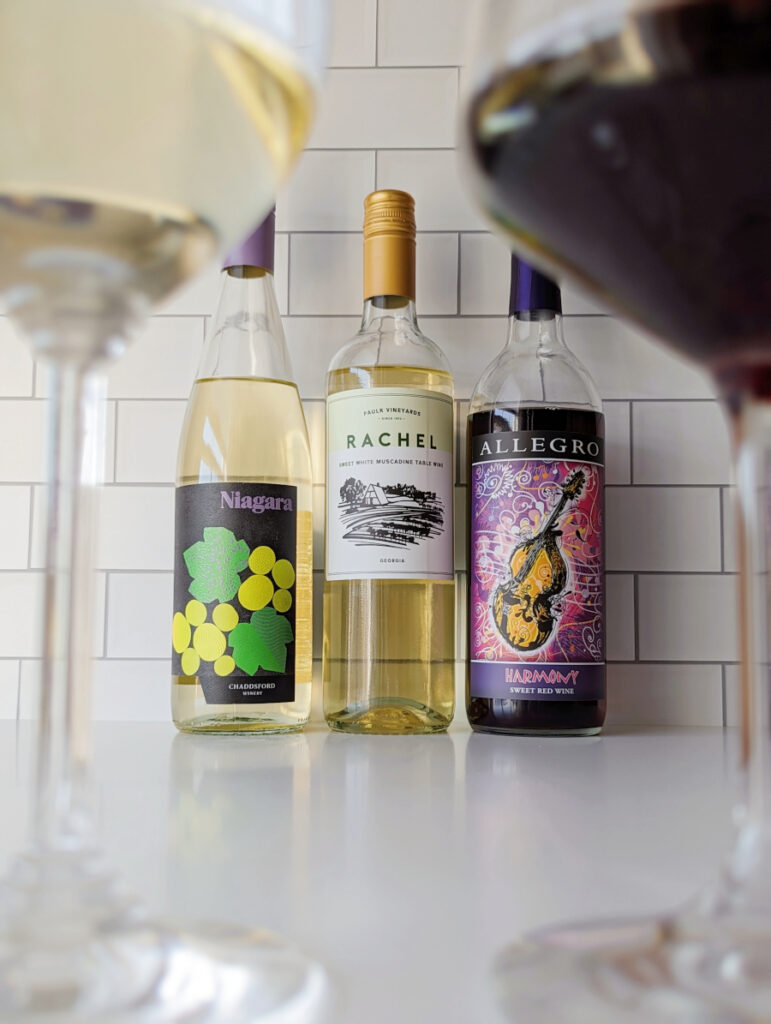
Photo by: Denise M. Gardner
What do these wines taste like?
Some key characteristics are prominently different between native grapes versus the European wine grapes. Often, these grape characteristics led to issues with the winemaking process or the carryover of sensory characteristics that were found undesirable by European wine standards. For example, many native grapes ripen with lower sugar concentrations compared to European wine grapes. Low sugar concentrations correlate into lower alcoholic wines, and throughout history, many native wines were fortified with alcohol in order to raise the final alcohol of the wine (Pinney, 1989). Many native grape varieties also have thick, astringent skins. In comparison, European wine grapes are thin skinned and easily breakable. In fact, varieties like Concord are considered “slip skin” in which you can press the grape together and the entire internal structure pops right out. European wine grapes have pulp that is attached to the skin of the grapes. Finally, the flavors associated with many native U.S. wine grapes is less refined than the aromas and flavors associated with European wines. I saw several texts that refer to native U.S. wine flavors as “wild.” As a wine expert, I have to admit that I’ve never called a native wine grape variety “wild.” However, the flavors often associated with these varieties are intense, obvious, pronounced, and easily identifiable.
Concord
The Concord wine grape is probably one of the more prominent varieties that is somewhat known by Americans across the country. Not only are Concord grapes the dominant grape variety used for red grape juice and red grape jelly, but the dominant flavor is, indeed, grapey. Methyl anthranilate, the component of Concord grapes that makes the grape flavor, is also used extensively to provide grape flavor to things like candies and sodas. Thus, if you have ever tasted something grapey, it’s likely you have been influenced by the primary flavor compound of Concord grapes.
Concord wines are considered “foxy” with a dominant grape flavor. The term “foxy” is somewhat controversial in the wine industry with numerous origin stories of what led to the popularity (and disgust) of the term. However, the key thing to remember about Concord wines is that they have a very strong grape flavor. Though the grape flavor dominants, it is not unusual to also note that the wines can be somewhat floral or even carry underlying fresh strawberry aromas. Due to the characteristics associated with the grapes, these wines also are fairly purple in color, lacking the brick red hue often associated with wine varieties like Cabernet Sauvignon and Malbec. However, the intensity of the purple color can range from being rather light and clear to incredibly dark. The sourness in the wine is usually notable, leading to a rather refreshing wine. And, due to the higher concentration of astringent components in the grape skin, it’s not unusual to get some astringency and/or bitterness from the wine.
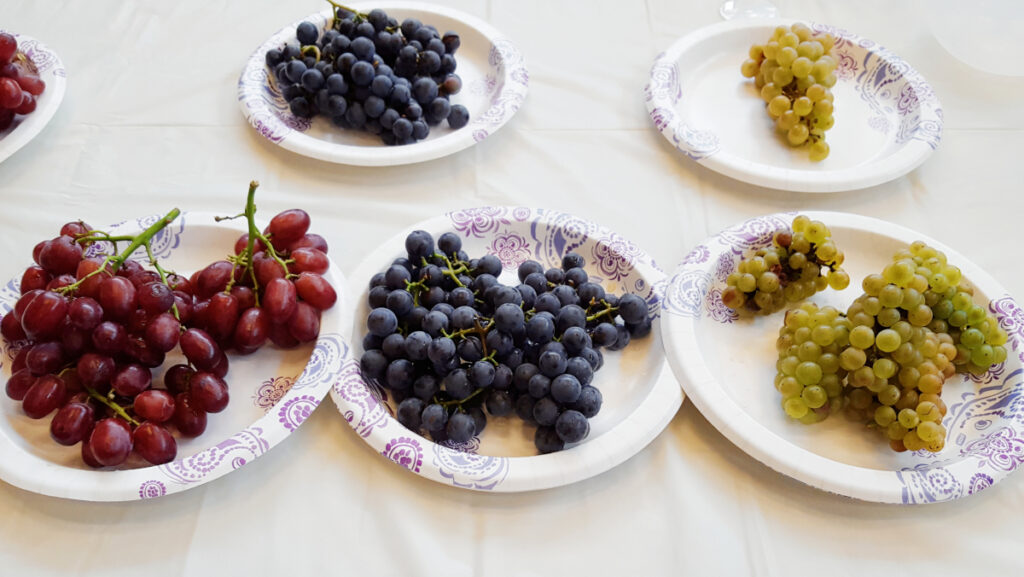
Photo by: Denise M. Gardner
Niagara
Like Concord, Niagara is also considered a “foxy” wine grape variety. It is likely that Niagara could be detailed to carry the greater concentration of foxy aroma, as the aroma compound o-amino acetophenone makes up a larger portion of the grape’s aromatic makeup. In fact, in the “Wine Grapes” classification text, Niagara is referred to as, “the foxiest American hybrid of them all” (Robinson, Harding, and Vouillamoz, 2012).
Like Concord, Niagara wines can be somewhat sour with noticeable astringency or bitterness. Their flavor, however, is not as grapey as Concord. In fact, I sometimes find it rather difficult to describe Niagara flavor. If you have had white grape juice, then it’s likely you know what Niagara wine tastes like from a flavor perspective. The flavors are somewhat grapey, but also rather floral, a little musky, with noticeable citrus notes, especially a lemon zest character. Sometimes, the wines can also have an oily-like aroma.
Muscadine
Muscadines are very different from the Concord and Niagara grapes and do not provide an overly grapey aroma or flavor. There are several types of Muscadines that grow prominently throughout the Southern U.S. Some may have some nuanced flavors that are unique to that individual cultivar. I find Muscadine wines musky, with a noticeable musk-perfume attribute. However, the white Muscadine wines that I tasted for this post were also citrus flavored with a light banana characteristic. They also had a resin character, which I’ve seen mentioned previously from other wine experts.
Pairing Native Wines with Food
I will admit that I grew up in the Northeast, and thus, most of my creative food pairings listed here are featuring the Concord and Niagara wines. However, that’s not to underestimate the culinary exploration of Muscadine wines. While Muscadine varieties have a unique flavor profile, they are not as dynamically pronounced as Concord and Niagara, in my opinion. Many Muscadine cultivars still have nuance, which is very wine-like.
- Muscadine Wine with Fried Chicken: Fried foods go with many different types of wines due to the fatty, fried coating that often meshes well with wine flavor. Most fried food pairings are centralized around white wines, and thus, many white Muscadine wines make a natural pairing with fried foods as well. The aromatic, musky nature of Muscadine wines can pair well with the oily, salty, crunchy characteristics of fried chicken. If you aren’t in the mood for fried chicken, you could even try Muscadine wine alongside plain potato chips.
- Muscadine Wine and Spicy Sauced Chicken Wings: Spicy foods pair best with sweet wines. The sweetness often helps tone down the higher alcohol in wines that can otherwise enhance the spiciness of the food. Since many Muscadine wines are sweet, they are a good option for trying with spicier foods. Plus, with a strong flavor composition, the wine can hold up well to spice, which can tone down the flavor of wine when paired together.
- Muscadine Wine with Roasted Turkey: Roasted turkey is somewhat bland, but it does have its own unique, warmed over flavor that can easily pair with wine. The unique flavor composition of Muscadine wine varieties also reminds me of the flavor diversity associated with holiday meals that are centered around a roasted turkey. Thus, I think Muscadines offer a similar wine experience for roasted turkey meals. Plus, in the spirit of holiday meals, many red Muscadine varieties have a cranberry essence as part of their flavor profile. Since cranberry sauce is often paired with roasted turkey, thus too, red Muscadines offer a natural wine and food pairing. Additional turkey pairings include honey roasted turkey sandwiches, roasted turkey legs, and ground turkey meatloaf.
- Muscadine Wine with Jambalaya: Feeding off of the sweet-and-spicy combination, Muscadine wines typically pair well with jambalaya. Given jambalaya’s typical spiciness with the combination of meats like shrimp and sausages, Muscadine wines can hold up against such dynamic and diverse flavors. Plus, the fresh acidity of the Muscadine wine can hold its own against the jambalaya spicy flavor.
The primary “difficulty” that many wine experts will find with Concord and Niagara wines are their intense flavors. However, the vibrant grape flavor is paired naturally with many foods (Page, 2008; Segnit, 2010). What I LOVE about these pairings, below, is that they elevate both the wine and the food when paired together. You can simply taste the pairings. Plus, it emphasizes how sweet wines can easily get paired with wines.
- Concord Wine with Peanut Butter: This is a play on the traditional “peanut butter and jelly” sandwiches, which is classically made with (you guessed it) Concord jelly. Concord goes marvelously with peanut butter, and thus, you can use this pairing in many different ways. Crackers and peanut butter make for an easy appetizer to pair with Concord wines. Salads dressed with a peanut dressing or chicken wings (or chicken satay) with a peanut sauce are another easy pairing. Peanut butter cookies with a sweet Concord wine – delicious. The trick with cookies is to ensure the Concord wine is sweeter than the cookie. (I previously discussed this requirement in the “Pairing Chocolate with Wine” Sip & Swirl edition.) Other recognizable peanut butter-based foods that would pair well with Concord wine include Pad Thai, spring rolls with peanut sauce, and, even, peanut soup.
- Concord Wine with Blue Cheese: The intense musty flavors associated with blue cheese are an excellent contrast to the grapey Concord wines. Plus, the sweetness associated with many Concord wines makes for a sweet-savory culinary masterpiece in your mouth. Try slices of baguette, lightly oiled and toasted, sprinkled with blue cheese crumbles and topped with a slice of walnut for an appetizer to go with Concord wine. A salad combination of lettuce, walnuts, fresh grape slices, celery, and blue cheese dressing will also go very well with Concord wine. Grabbing some fresh veggies, buffalo chicken wings, or buffalo sauce cauliflower bites dipped in blue cheese dressing are going to pair well with Concord. Another great suggestion includes any type of steak that is topped with a blue cheese dressing, crumbles, or crust. Even a blue cheese burger could pair well with Concord. Final thought: bacon, blue cheese mac n’ cheese with Concord wine… delectable!
- Niagara or Concord Wine with Soft Cheeses: Both ricotta and mascarpone cheeses are soft, light, spreadable cheeses that pair well with dynamically grapey wines like Concord and Niagara. Again, slices of toasted baguettes topped with ricotta or mascarpone and a walnut on top will make a delicious and simple appetizer to pair with Concord or Niagara wines. You could also add a slice of prosciutto to those combinations to add some extra salty and savory characters that pair well with the wines. Or try the cheese-toast combination with rosemary focaccia crostini topped with fresh ricotta and a slice of peach to go with both Concord or Niagara wine.
- Concord Wine with Roasted Chicken or Pork Loin: When grapes are roasted in olive oil, salt, pepper, and spices (rosemary, thyme, and fennel), they make for a sweet and savory sauce that pairs well with white meats like roasted chicken or pork. The same is true with reduced wine. I love the idea of using a wine-marinade or a reduced wine sauce for covering a roasted chicken or pork loin fresh from the oven. Using rosemary as a topping spice with a little bit of salt and pepper is going to pair fabulously with Concord wine.
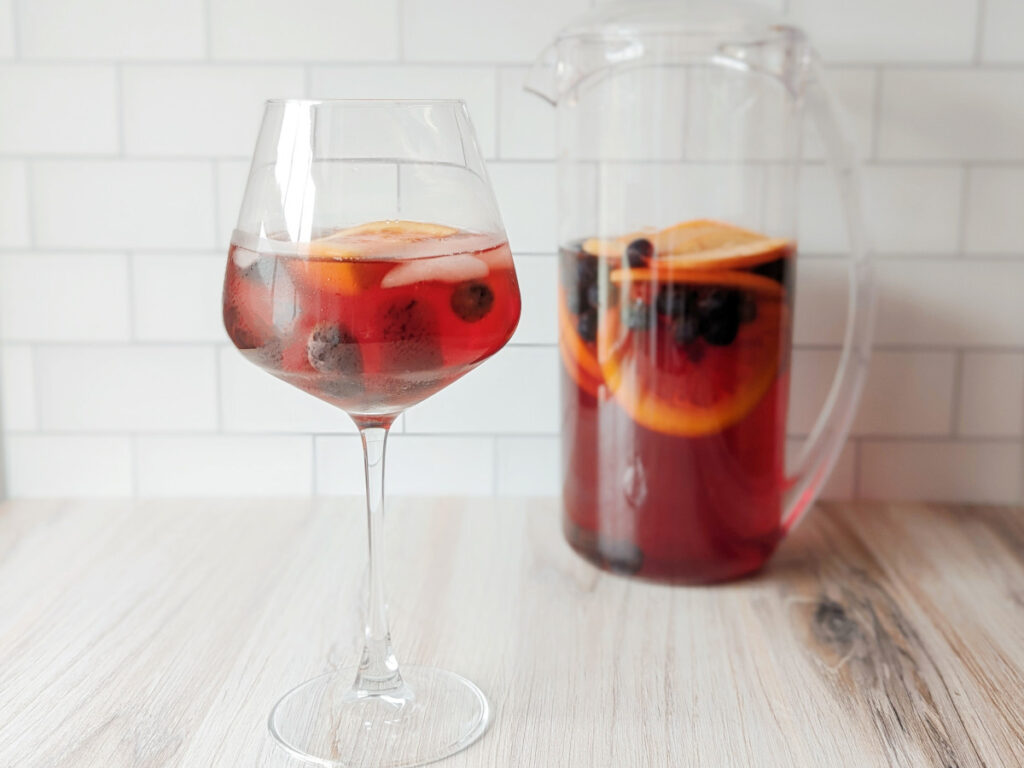
Photo by: Denise M. Gardner
A Concord Sangria
Remember, while many wines of these varieties are often sweet, not all producers make Concord, Niagara, or Muscadine wines with noticeable sweetness.
That being said, if you love sweet wines, these varieties tend to be great wines to try.
Whether you receive a Concord wine as a gift and don’t prefer its sweetness, or you just love Concord, I’ve created a Sangria recipe that ALL wine lovers will enjoy. For those people that do not enjoy overly sweet wines, this Sangria recipe helps tone down the sweetness. Of course, if you love sweet beverages, you can bump up the sweetness by substituting ginger ale or lemon/lime soda for the seltzer water. Or, add your favorite sweetener until the Sangria is sweet enough to your preference.
- 1 Bottle of Concord Wine
- 1/4 Cup of White Rum
- 1/4 Cup of Triple Sec
- 1/8 Cup of Peach Brandy (About 40 mL)
- 1/8 Cup of Chambord (About 40 mL)
- 1.5 – 2 Cans of Peach or Raspberry Sparkling Water
Optional fresh fruits to add: Apple slices, peach slices, orange slices, raspberries, and/or blueberries. Garnish with a fresh mint sprig and/or orange peel twist.
Resources
Page, K. and A. Dornenburg. (2008) The Flavor Bible. ISBN: 978-0-316-11840-8
Pinney, T. (1989) A History of Wine in America: From the Beginnings to Prohibition. Vol. 1. ISBN: 978-0-520-25429-9
Pinney, T. (2005) A History of Wine in America: From Prohibition to Present. Vol. 2. ISBN: 978-0-520-25430-5
Robinson, J., J. Harding, and J. Vouillamox. (2012) Wine Grapes. ISBN: 978-0-06-220636-7
Segnit, N. (2010) The Flavor Thesaurus. ISBN: 978-1-60819-874-0

